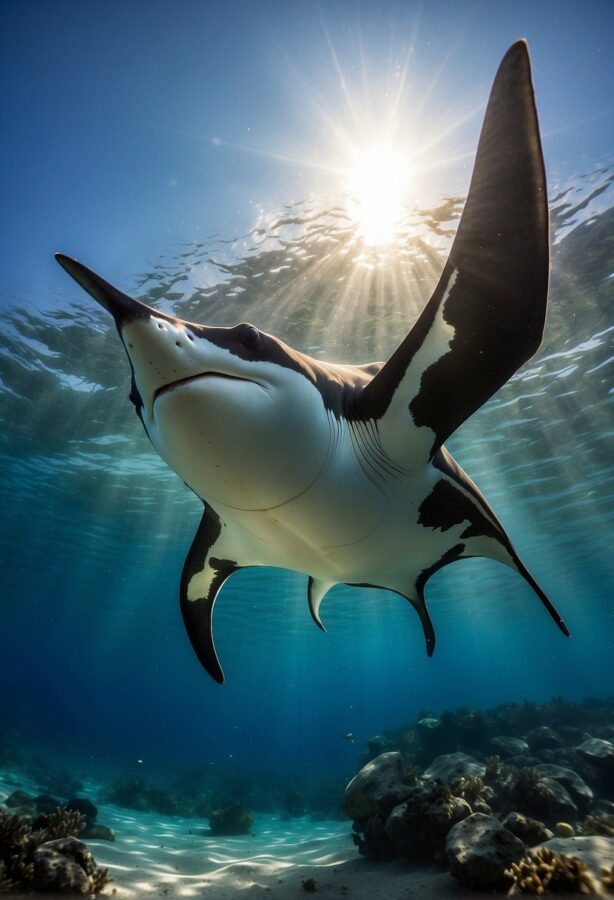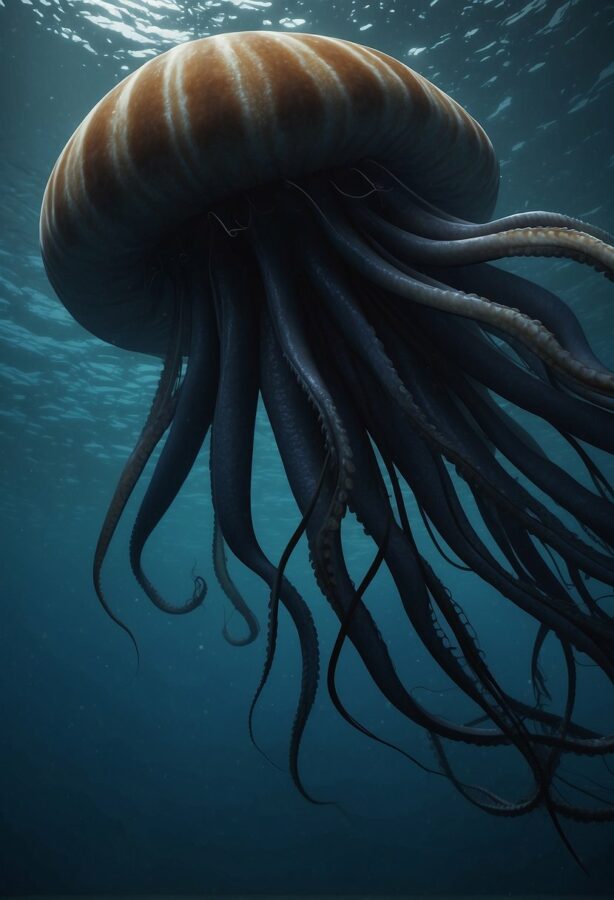The vast expanse of the ocean is home to a mesmerizing array of life, from the tiniest plankton to the colossal blue whale. Capturing the essence of these creatures through photography offers a glimpse into a world that is largely inaccessible to us.
The crystal-clear images of ocean animals, sourced from repositories such as Getty Images, often come in royalty-free formats, allowing educators, conservationists, and enthusiasts to share and use these visuals without entanglement in legalities. These photos serve as more than just visual delights; they are a window to the underwater universe, where each click of the camera enhances our understanding and appreciation of marine biodiversity.

The allure of exclusive visuals of ocean life extends beyond the realm of pure fascination. Editorial content related to world events, entertainment, and celebrity coverage has utilized imagery from beneath the waves to draw attention to relevant issues such as ocean conservation. With each snapshot of vibrant marine ecosystems and the creatures that inhabit them, a story unfolds.
These stories not only highlight the beauty of ocean dwellers but also prompt viewers to consider the fragility of these habitats. Photos of sea turtles or pods of orcas stir the imagination and inspire awe, and they also bring to the fore the pressing need for protection methods like reducing plastic use, practicing sustainable seafood consumption, and supporting marine protected areas.
As audiences marvel at the high-resolution images of seahorses dancing or the playful antics of dolphins, it’s essential to remember the hand of humanity in either the safeguarding or the demise of these scenes. Photographs, particularly those tailored for news photos, entertain their viewers while subtly educating them about the significance of these ecosystems. A vibrant capture of coral spawning or a regal jellyfish in motion doesn’t just satisfy the quest for beauty—it reinforces the imperative to commit to ocean conservation efforts and thereby ensure that such awe-inspiring moments continue to flourish beneath the waves.
See Related: The Appetite of Sharks: Unveiling What Lies on Their Menu
The Majestic Whale Shark

Whale sharks, the titans of the ocean, command an awe-inspiring presence in the aquatic world. These gentle giants are not only the largest fish in the sea, with lengths of up to 32 feet, but they also embody a serene grace, swimming among the myriad life beneath the waves.
Habitat and Behavior:
These sharks favor warm, tropical oceans and are often seen gliding near the surface, where they filter feed on plankton. They are a migratory species, and their seasonal appearances are often awaited by both researchers and enthusiasts.
Conservation:
Every photograph capturing the whale shark’s grandeur serves as a poignant reminder of the ocean’s fragility. Observers are encouraged to:
- Support sustainable seafood choices.
- Reduce plastic use to keep their habitats clean.
Visual Documentation:
Stunning high-quality images and videos have immortalized whale sharks, creating iconic moments in natural history. Illustrations and vectors often used in educational materials further highlight their distinct patterns of spots and stripes, unique to each individual shark.
Photographers seek to pair their visuals with original audio content to enrich the viewing experience, often accompanied by music that complements the serene spectacle.
Interaction with Humans:
Whale sharks are known for their docility, allowing for close human interaction. This has promoted eco-tourism, where guidelines ensure interactions are non-intrusive and respectful. To protect these creatures:
- Follow responsible wildlife viewing practices.
- Contribute to organizations working for their conservation.
Preserving the existence of whale sharks ensures future generations will continue to be inspired by their majestic beauty and the rich biodiversity of our oceans.
The Graceful Manta Ray

The Manta Ray, a titan of the ocean, commands awe as it glides through the water with its massive wingspan that can reach up to 23 feet. These majestic creatures, resembling birds in underwater flight, possess the largest brain-to-body ratio of any cold-blooded fish, hinting at a high level of intelligence. Their feeding rituals are complex, involving coordinated movements that create a ballet of grace and precision.
Enthusiasts can browse royalty-free images or watch videos showcasing these spectacular fish to gain creative insights into their behavior. These media can be downloaded for personal education or to spread awareness of the Manta Ray’s role in the ocean’s ecosystem. Here’s a brief overview of their unique features:
- Wingspan: Typically 12 to 23 feet
- Diet: Plankton, filtered through specialized plates
When viewing images or footage of Manta Rays, each photo can be a reminder of the ocean’s fragility. Conservation tips include:
- Support Sustainable Fisheries: Ensure seafood consumption doesn’t harm Manta Ray habitats.
- Responsible Tourism: Choose eco-friendly tours that respect Manta Ray environments.
The conservation of these ocean giants is critical. They face threats from overfishing and habitat destruction. By spreading knowledge and admiration through the shared visuals of Manta Rays, one can inspire a collective effort to protect and cherish these awe-inspiring inhabitants of the sea.
The Mysterious Giant Squid

The giant squid remains one of the ocean’s most awe-inspiring enigmas. Capturing exclusive visual content of these elusive cephalopods is a rare feat due to their deep-sea habitat. Outfitted with basketball-sized eyes, the Architeuthis dux can evade even the most determined researchers.
Feature | Description |
|---|---|
Size | Can reach over 16 feet in length |
Eyes | Among the largest in the animal kingdom |
Tentacles | Extend up to 33 feet, adorned with suckers |
Habitat | Deep ocean, elusive to human observation |
Editorial photographs or film clips usually capture them in a fascinating, albeit deceased state, often washed up on shores. Recent advances in deep-sea technology, however, have offered royalty-free glimpses into their natural, dynamic majesty.
The Medusa camera system is one such innovation, enabling scientists to observe these giants in their domain. It reinforces the importance of protecting the habitat of such creatures from human interference and pollution.
Each photo of the giant squid not only feeds news outlets with fresh editorial material but also serves as a poignant reminder of ocean conservation. These images embody the call for reduced deep-sea fishing activities and the limitation of pollutants that can disrupt the complex ecology of these titans.
When sharing this content, one might emphasize the significance of reducing single-use plastics to preserve the clarity of our waters for future, undisturbed encounters with the giant squid. Such actions ensure that the ocean’s wonders continue to inspire generations to come.
The Vibrant Coral Reef

Coral reefs, often referred to as the rainforests of the sea, are some of the most biologically diverse ecosystems on Earth. Royalty-free images capture their sheer beauty, allowing anyone to appreciate the intricate dance of marine life from the comfort of their own home. These creative content pieces offer a glimpse into an underwater world filled with a kaleidoscope of colors and shapes.
One will often find a mesmerizing variety of fish weaving through the elaborate structures built by corals, which are living organisms. Brightly colored parrotfish, delicate seahorses, and swift damselfishes are just a few of the inhabitants that rely on these reefs for shelter and food.
Careful ocean management and conservation efforts are essential to maintaining this habitat’s health. For each image of fish thriving among the corals, let it be a reminder to avoid overfishing and to support sustainable seafood practices.
Turtles and dolphins also frequent these underwater cities, adding to the dynamic tapestry captured in these images. The presence of a turtle gliding gracefully over the reef can inspire viewers to reduce plastic use, as marine debris can be a death trap for these ancient mariners. Imagery of a curious dolphin amidst the coral labyrinth should encourage efforts to protect marine areas from pollution and intrusive human activities.
Ocean scenes featuring coral reefs are not just visually stunning; they are crucial for marine life. Proactively sharing images and informing others about the importance of these ecosystems can foster a sense of stewardship and awe for the ocean’s fragility and majesty. Each photo of this extraordinary habitat stands as a powerful testament to the importance of conserving the world’s coral reefs.
See Related: Otters as Pets: Everything You Need to Know About Otter Ownership
The Playful Sea Otter

The sea otter is an iconic marine mammal known for its charming antics and dense, luxurious fur. Photographers and videographers, from professionals to talented creators utilizing user-generated content apps, capture these enchanting creatures both in spontaneous play and serene moments.
Appearance: They boast the thickest fur in the animal kingdom, with up to a million hairs per square inch. In photos or videos, their plush coats are a captivating sight, often causing viewers to marvel at their texture and warmth that shields them in the cold ocean waters.
Behavior: Sea otters are often depicted using tools—a rare ability among mammals. This behavior makes for fascinating photos and videos, showcasing their ingenuity as they use rocks to crack open shellfish. Their problem-solving skills are highlighted across various platforms, with free photos and videos available on iOS and Android apps showcasing their delightful behaviors.
Social Structure: Images and video footage commonly show sea otters floating together in groups called rafts, demonstrating their sociable nature. These visuals, often shared by ocean enthusiasts and conservationists, inspire awe and foster a connection between the audience and these aquatic animals.
Conservation Note: Each image of a sea otter comes with a critical message of conservation; their populations are threatened by oil spills and pollution. Photographs serve as a reminder to support efforts in maintaining pristine habitats for these mammals. When sharing sea otter content, encourage actions such as supporting wildlife organizations and advocating for pollution prevention measures.
The Gliding Sea Turtle

The sea turtle’s grace is often captured in various illustrations and photographs, serving as a visual testament to its serene beauty. These majestic reptiles have been gliding through the world’s oceans for millions of years. The gentle manner in which they navigate the aquatic environment is awe-inspiring and a frequent subject for photographers and marine life projects aiming to raise awareness through exclusive visuals.
- Visuals & Insight: Professional images offer a VisualGPS search insight into the turtle’s natural habitat, providing an educational glimpse into their underwater world.
- Browsing Possibilities: Avid enthusiasts can browse through a myriad of photos, showcasing everything from the intricate details of the turtle’s shell to their interactions with other marine life.
Conservation Tip | Photo Depiction |
|---|---|
Reduce plastic usage to prevent ocean pollution. | A turtle glides past a discarded plastic bag, highlighting the juxtaposition of natural beauty against human waste. |
Support organizations protecting sea turtle nesting sites. | A photo captures turtles on a beach, emphasizing the importance of safe nesting grounds. |
Photographers often seek out interactions where turtles visit cleaning stations, attended by other fish—a symbiotic moment that underscores the interconnectedness of ocean ecosystems. Such exclusive visuals serve not only as breathtaking glimpses into the marine world but also as crucial educational tools.
The sea turtle encapsulates the awe of ocean life, and through compelling reptile photography, they become ambassadors for the oceans’ fragility. Each image is an invitation to honor and protect these ancient navigators of the seas.
The Schooling Hammerhead Sharks

Hammerhead sharks are a magnificent sight in the ocean, often found cruising the temperate and tropical waters in schools. These creatures display a unique form of congregation, where multiple individuals come together, creating an awe-inspiring display of marine life that photographers and videographers eagerly capture. An array of this footage is available for download, some of which can be found with accompanying Getty Images music or sourced through Epidemic Sound to enhance the visual experience.
Table 1: Notable Hammerhead Shark Characteristics
Length | Weight | Coloration |
|---|---|---|
3-20 feet | Up to 1,278.7 pounds | Gray with a greenish tint and white bellies |
While they may resemble the notorious great white shark in their predatory nature, hammerhead sharks have a distinct presence in the ocean. They contribute significantly to the balance of marine ecosystems, preying on fish including groupers, which they hunt in the stunning coral reefs found off the coast of Australia.
Conservation Tip: Avoid disturbing their natural habitat when capturing footage or photographs. This ensures the continuation of their hunting patterns and helps maintain the delicate balance of the coral ecosystems.
However, not all images of hammerhead sharks are suitable for commercial use. Photographers should always verify the licensing of their images, especially those intended for commercial projects, to respect copyright laws and support ethical wildlife photography practices.
Conservation Tip: Choose royalty-free or appropriately licensed images for commercial projects to support conservation efforts and respect the photographers’ work.
Witnessing schools of hammerhead sharks is truly an extraordinary experience that highlights the remarkable diversity and elegance of ocean life. The powerful yet harmonious movement of these schools through the vast blue illustrates the ocean’s beauty and the importance of preserving such scenes for future generations.
Conservation Tip: Support organizations that protect shark species and their habitats to ensure scenes like schooling hammerhead sharks continue to inspire awe and respect for the ocean’s inhabitants.
See Related: Exploring the Enchanting Jellyfish Habitat: A Fascinating Underwater World
The Luminous Jellyfish

The ocean is a theater of ever-changing vistas, and perhaps its most captivating act is the luminous jellyfish. These residents of the ocean’s murky depths have developed the astonishing ability to produce light, a phenomenon known as bioluminescence.
When one observes jellyfish through videos or high-definition photos, the brilliance of their luminescence elicits an awe-inspiring reaction. Captured in their natural habitat, these creatures appear as ethereal beacons against the dark canvas of the ocean.
Bioluminescence:
- Purpose: Communication, predation, and defense
- Mechanism: Chemical reaction involving luciferin and luciferase
Photos and Illustrations:
- Illuminate the jellyfish’s complex systems
- Highlight the diversity among bioluminescent species
As enticing as these images are, they also serve a crucial educational purpose. By expanding awareness, they often advocate for the conservation of these delicate creatures and their habitats. In each visual encounter, whether through photos or illustrations, viewers can be inspired to support ocean preservation. Jellyfish visual content, when marked ‘exclusive’, assures viewers of authentic and untouched glimpses into their underwater world.
Conservation Tips Per Photo:
- Respect habitats: When engaging in ocean activities, avoid disturbing jellyfish and their ecosystems.
- Sustainable seafood choices: Choosing sustainably-sourced seafood can reduce the impact on jellyfish populations and the broader ocean community.
Vectors and animations bring a dynamic angle to understanding jellyfish, representing their movement with artistic liberty, drawing spectators into their underwater ballet. The crab and other crustaceans occasionally appear alongside jellyfish in these visual renditions, each organism part of a larger ocean tapestry that is fragile and demands protection.
Educators and conservationists lean on these depictions to inspire the safeguarding of our oceans, turning awe into action.
The Stealthy Moray Eel

The moray eel embodies an almost otherworldly presence in the ocean depths. Often misunderstood, these creatures play a crucial role in their marine ecosystems. Their sinuous bodies allow them to navigate the complex architectures of coral reefs and rocky crevices, making them masters of ambush. Their variegated skin ranges in color, effectively camouflaging them amidst the vibrant sea life.
Moray eels primarily feed on smaller fish and crustaceans. An encounter with a sea lion or seals, though rare, can be a dramatic scene, as these larger marine mammals are often top predators in their environments. Yet, it is the eel’s interactions with smaller sea creatures that most vividly capture their essence:
- Diet:
- Fish
- Crustaceans (e.g., lobsters)
- Mollusks (clams, oysters)
Capturing images of moray eels can serve as a powerful tool for ocean conservation. Each photo should be accompanied by a tip to protect the marine world:
- Photograph with Sealife: A moray eel coiled among starfish and clams
- Conservation Tip: Maintain a safe distance to avoid disturbing these delicate habitats.
- Moray Eel and Crustaceans: A shot of an eel eyeing a lobster
- Conservation Tip: Support sustainable fishing practices to ensure the balance between predator and prey remains stable.
Moray eels, while awe-inspiring, are often underrepresented in media. They deserve a spotlight in editorial content, news features on marine biodiversity, and even within entertainment channels that showcase the wonders of ocean life. Archives and collections of ocean photographs must include the stealthy moray to educate and inspire awe for these remarkable creatures. Through understanding, one can foster a greater connection to the sea and a commitment to its preservation.
Related Resources: